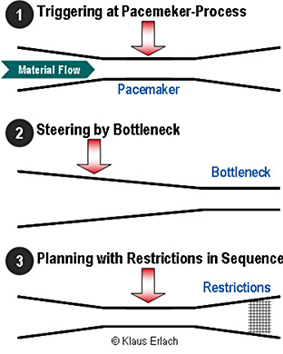Content
3 Value Stream Design
Value stream design enables a complete redesign of a production to achieve an efficient and customer-oriented value stream. The goal-oriented, experience-related application of these clear design guidelines systematically leads the current-state value stream towards an optimized future state. The efficiency is further increased through avoidance of waste. This results in a well-arranged depiction of the targeted future state of a lean production.
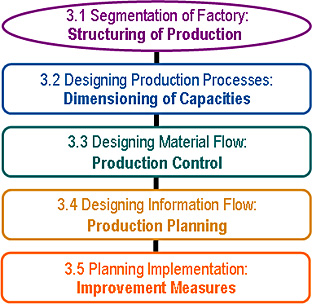
3.1 Production Structuring
The essential goal of product family-oriented segmentation is the strict disentanglement of the material flows to create a transparently structured shop floor with a view to products and production processes. The range of products is sub-divided into product families with a view to production procedures and business types. Finally, the resulting product families are allocated their required resources.

3.2 Production Process Design
In value stream design, the customer takt time determines the target for the capacitive dimensioning of the resources. The operator balance chart reflects the level of success with a view to the capacitive dimensioning of a production in relation to the takt time.
Design guideline 1 applies: Adjustment to takt time - The capacity availability of a production has to be adjusted to the customer takt time throughout in order to reach a balanced capacity profile of the value stream.
Continuous flow production realizes the ideal way of producing. Production lead times are minimized, maximum production quality is enabled, even required, waste in the production process is reduced, and variant mixes may be aligned with the customer demand.
Design guideline 2 applies: Process integration - Production processes have to be consolidated as continuous flow production or integrated production as far as possible to minimize waste.

3.3 Production Control
Many obstacles encountered in production control result from the prognostic dilemma of production planning. Disturbances caused by incorrect customer demand forecasts and/or unreliable suppliers lead to turbulences which may prevent delivery dates being met in spite of careful planning.
Complex production control systems (such as APS) try to control all turbulences on a planning level. This requires high planning and control effort, accompanied by general intransparency in order processing and production as well as certain stability risks, in particular with a view to erroneous data and feedback. This is the eighth type of waste.
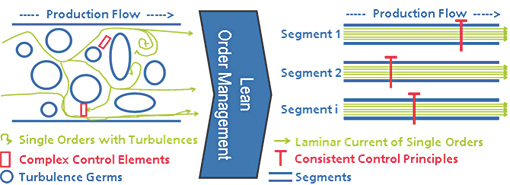
Lean production control aims at an even, easily manageable production process which creates a consistent laminar production flow. For high production, fix order processing sequences must be strictly adhered to, short lead times resulting from low inventories must be striven for and orders must be triggered at exactly one production process. The following guidelines apply
Design guideline 3 applies: FIFO coupling - Consecutive production processes, which can't be integrated in continuous flow production for technological or organizational reasons, should be coupled as a line production with limited inventory levels as far as possible.
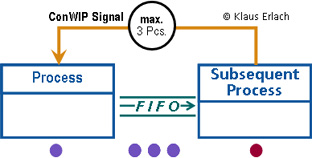
Design guideline 4 applies: Kanban control - Production processes for multiple usage parts with high changeover times, low reliability or highly differing cycle times should be connected by lot production with supermarket stores.

Design guideline 5 applies: Pacemaker process - Each value stream should be triggered in takt time at one definite point, the pacemaker process.
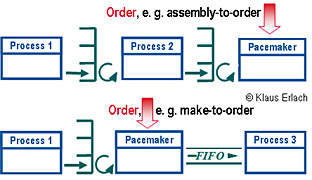
3.4 Production Planning
Production planning converts customer orders into production orders for the pacemaker process to ensure a balanced production load. This requires balanced order release aligned with the value stream's capacity profile.
Design guideline 6 applies: Definition of release units - The release of production orders has to be done in small, standardized dimensioned amounts to reach an even production volume.
Design guideline 7 applies: Levelling the production mix - The sequence of production orders has to be thoroughly intermixed concerning the variants to reach a balanced production variety.

Design guideline 8 applies: Bottleneck control - The release of production orders is subject to quantity or sequence-related control depending on possible capacitive and/or restrictive downstream bottlenecks.
